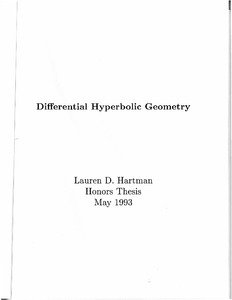| dc.rights.license | In Copyright | en_US |
| dc.creator | Hartman, Lauren Danielle | |
| dc.date.accessioned | 2023-10-20T18:01:56Z | |
| dc.date.available | 2023-10-20T18:01:56Z | |
| dc.date.created | 1993 | |
| dc.identifier | WLURG038_Hartman_thesis_1993 | |
| dc.identifier.uri | https://dspace.wlu.edu/handle/11021/36559 | |
| dc.description.abstract | In this paper, we develop two model spaces for hyperbolic geometry using differential calculus. Our approach is to first develop the Euclidean model space R[2] and then mirror the development for hyperbolic geometry. The differential approach is advantageous because it provides a metric for each geometry. This enables us to develop the geometric isometries. A geometric isometry of two dimensional space X is a one-to-one function from X into X that preserves distance and preserves angles. Felix Klein in 1872 pioneered the viewpoint that a geometry is reflected by its isometries. Thus, by developing the concept of a hyperbolic metric we can find the hyperbolic isometries and hence better understand hyperbolic geometry. [From Introduction] | en_US |
| dc.format.extent | 37 pages | en_US |
| dc.language.iso | en_US | en_US |
| dc.rights | This material is made available for use in research, teaching, and private study, pursuant to U.S. Copyright law. The user assumes full responsibility for any use of the materials, including but not limited to, infringement of copyright and publication rights of reproduced materials. Any materials used should be fully credited with the source. | en_US |
| dc.rights.uri | http://rightsstatements.org/vocab/InC/1.0/ | en_US |
| dc.subject.other | Washington and Lee University -- Honors in Mathematics | en_US |
| dc.title | Differential Hyperbolic Geometry | en_US |
| dc.type | Text | en_US |
| dcterms.isPartOf | WLURG038 - Student Papers | en_US |
| dc.rights.holder | Hartman, Lauren Danielle | en_US |
| dc.subject.fast | Geometry, Hyperbolic | en_US |
| dc.subject.fast | Differential equations, Hyperbolic | en_US |
| local.department | Mathematics | en_US |
